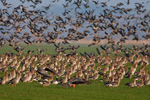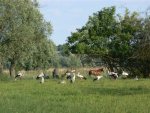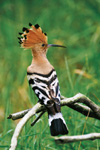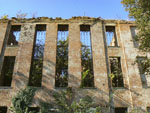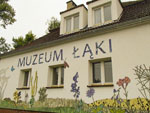Ujście Warty (the Warta Mouth) and surroundings
Location
Ujście Warty - The Warta Mouth is an area on the lower Warta and the middle Odra, in Lubuskie region, adjacent to the Polish-German border, in sulęciński, słubicki and gorzowski districts. Słońsk (formerly Sonnenburg) is a village (c. 3000 inhabitants) situated in sulęciński district. It is located only 16 km from the border crossing-point in w Kostrzyn nad Odrą, less than 100 km from Berlin, 120 km from Szczecin and Zielona Góra and 160 km from Poznań. Słońsk is located in a district, with the lowest of population density in Lubuskie region - only 32 persons/km2 (average for Poland - 123 persons/km2). It is appreciated especially by our guests from Warszawa, Małopolska i Śląsk and from Germany and the Netherlands.
The name itself Ujście Warty - the Warta Mouth already indicates the location of this place. Tthe place, where the Warta ends and flows into the Odra river, a wide valley spreads out, which is part of Toruńsko-Eberswaldzka proglacial stream valley. Over 250 back, the part of the Warta behind Gorzów was divided into many meandering arms, which formed an inland delta, flowing into the Odra south of Kostrzyn. The Warta wetland (Warthe Bruch)was flooded by both rivers and o riparian forest grew in the area. Nowadays the lower Warta valley is drained and deforestated. Extensive farming system does not disturb existence of extremely attractive habitats vital for Poland and Europe.
The vicinity of Słońsk is dominated by open areas distinct from the rest of Lubuskie region, where about 50% of the land is covered with woodland. Periodically flooded meadows and pastures partly covered by willow trees and bushes cut overgrown old drainage canals. Dozens of kilometers of embankments make nature observation easy during walking and biking. The wide and flat valley is surrounded in the north and south by morainal hills and lakes creating a beautiful postglacial landscape. Among dominant coniferous forests in Lubuskie Lake District, you can also find pieces of interesting old deciduous woods - beech-, dry-ground-woods and alder carrs.
Nature
Ujście Warty - the Warta Mouth is the name of a few protected areas: national and landscape parks, Important Bird Area of European Union importance (IBA) and Natura 2000 site PLC 080001.
Special Area of Conservation protects 14 habitat types of UE importance among others: natural eutrophic lakes with Magnopotamion or Hydrocharition - type vegetation, Alluvial forests with Alnus glutinosa and Fraxinus excelsior (Alno-Padion, Alnion incanae, Salicion albae), rivers with muddy banks with Chenopodion rubri p.p. and Bidention p.p. vegetation and Semi-natural dry grasslands and scrubland facies on calcareous substrates (Festuco-Brometalia). 9 fish species listed in Annex to habitat directive e.g. weatherfish, miller's-thumb, bitterling and lampreys are worthy of notice. Special Protection Areas - SPA protects birds and their habitats. Even during a short visit to the Słońsk area you may observe many rare species such as:
- Corncrake, Scarlet Rosefinch, Crane
- Black-Tailed Godwit, Oystercatcher, Ruff
- Kingfisher, Hoopoe
- White-tailed Eagle, Black Stork,
- Shelduck, Red-necked and Black-necked Grebes
- Black- Little and Whiskered Terns
Warta floodplain, as one of the most important european wetlands of international importance, has been on the Ramsar List since 1984. About 270 bird species have been registered there, over 170 of them have bred in the area recently. In spring the Ujście Warty National Park is very important due to the breeding area of many rare and endangered bird species and the high density of some Polish bird populations. It concerns e.g. Shelduck, Gadwall, Oystercatcher, Shoveler, Greylag Goose, Red-necked and Black-necked Grebes, Black Tern and Little Gull.
The park is also a very important habitat for moulting, migrating and wintering birds. Flocks of 10-20 (sometimes over 100) Black Storks are very common in July/August. Outside the breeding season the park can hold Tundra Bean and White-fronted Geese (even up to 200 000), Cranes (around 20 000), ducks (78 000) and Whooper Swans (2 500).
White-tailed Eagles, which can be observed all year round, are most numerous in winter (50 is the maximum number observed).



 Biuro Turystyki Przyrodniczej
Biuro Turystyki Przyrodniczej



